Scrum Basics: The Simple but Comprehensive FAQ Guide
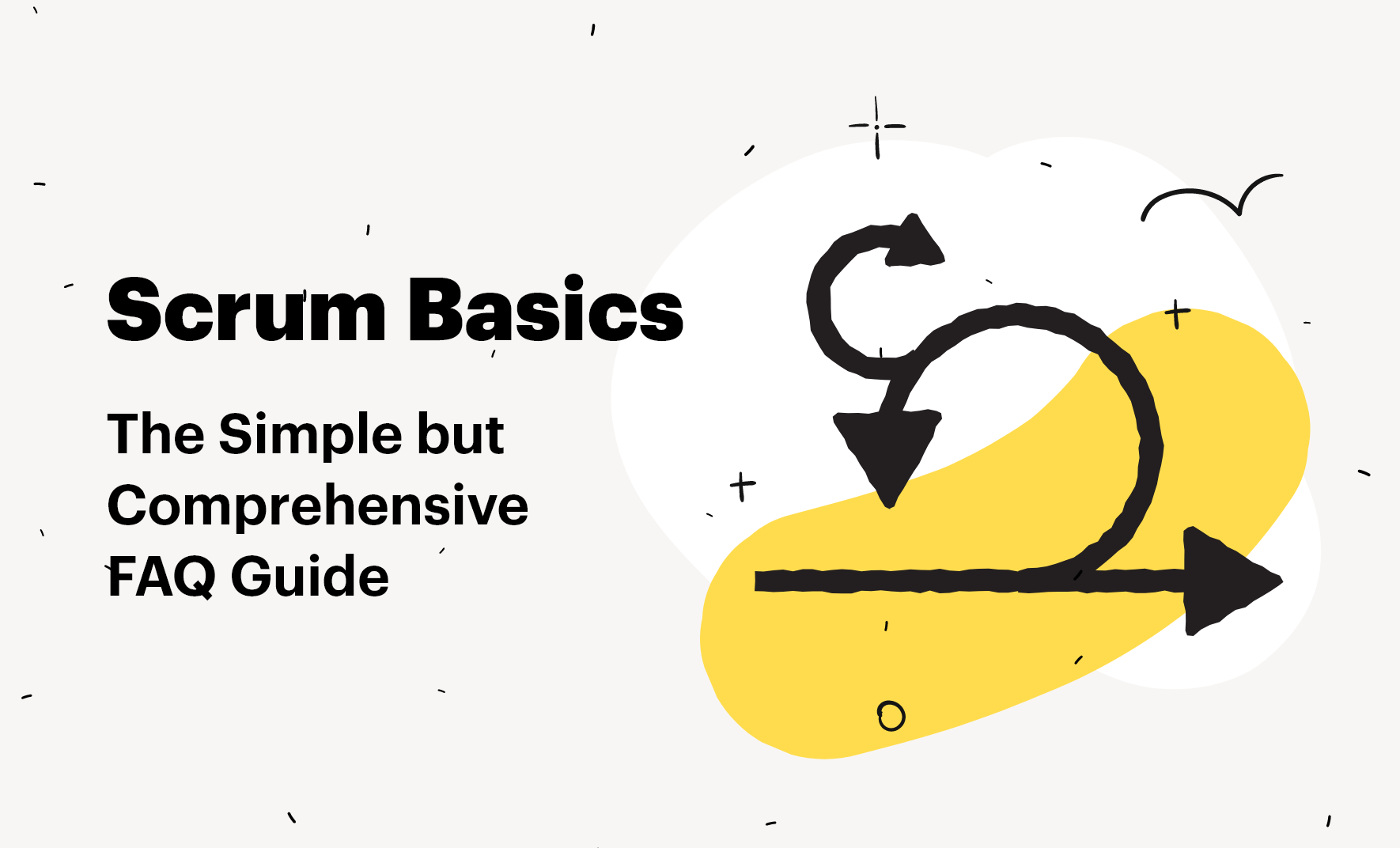
Scrum basics
Firstly, Scrum is the most popular framework used in the Agile philosophy and is used worldwide by all different organizations, but especially in the field of software and application development. In this FAQ guide, we’ll cover the Scrum basics one by one to give you a complete picture of the process, roles, core values, and everything else.
1. What is Scrum?
Scrum is a system that uses Agile principles and values to help teams work together. As a result, the team produces rapid results with a great deal of self-organization and flexibility.
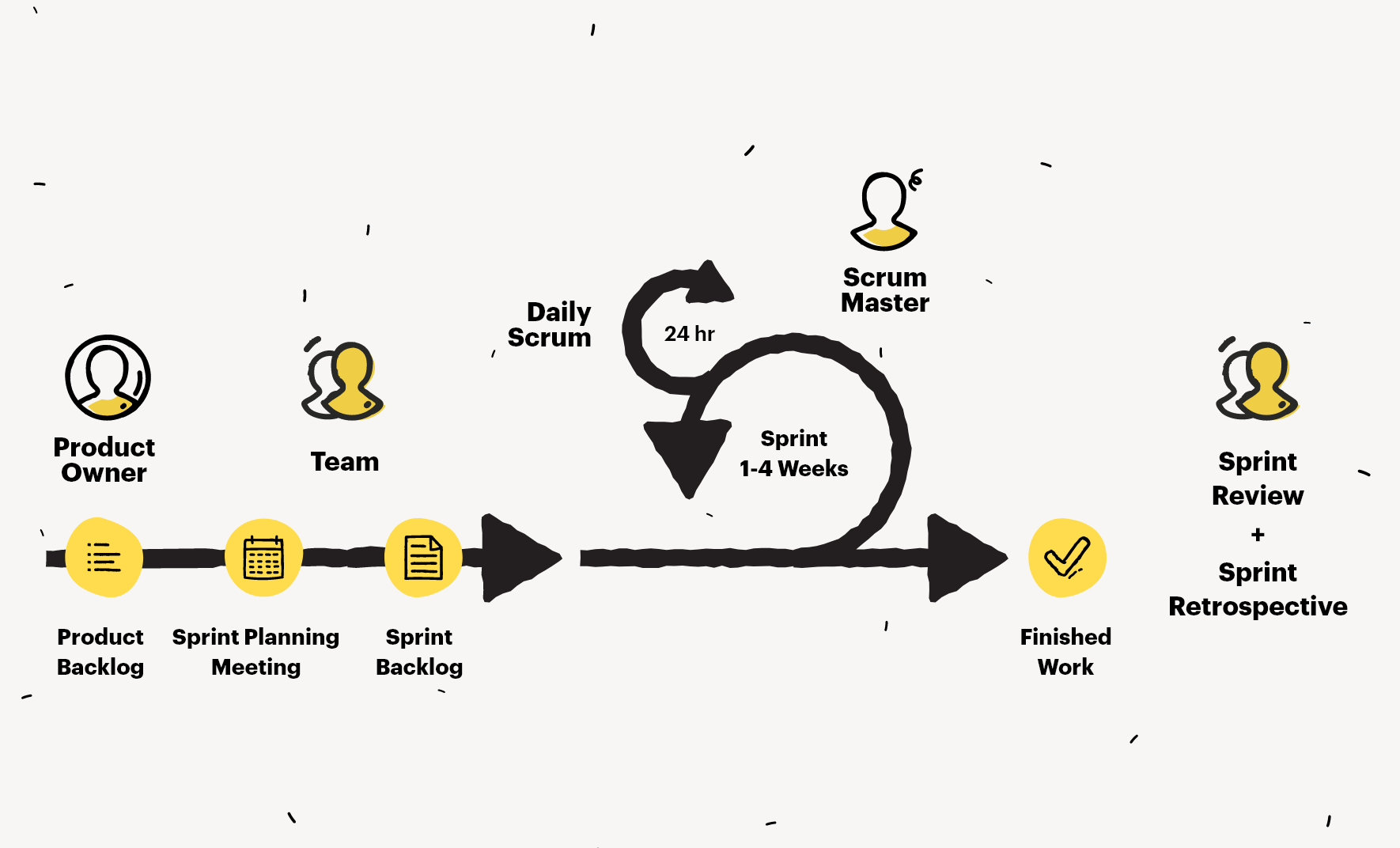
2. What are the key Scrum basics?
Controlling the process. Clarity, openness, constant and consistent checks, and adaptation and flexibility.
Self-organization. An emphasis on responsibility, This principle increases the level of independence of the whole team and also checking performance.
Collaboration. Awareness, clarity, and distribution are the main factors of the established work.
Value-based prioritization. Scrum methodology focuses on attaining all business tasks from the very beginning of the development process.
Timeboxing. Time is the center of the key Scrum basics as it’s always a limited resource and needs using wisely. Development management process, using Scrum methodology, includes sprints, daily meetings, meetings on sprint planning, and etc.
Iterative development. The process itself is divided into certain steps each of which requires a certain amount of work and, finally, satisfies user needs and conducts all set business tasks.
3. What are Scrum roles?
There are three clearly defined roles within a Scrum and each role comes with certain responsibilities. These roles are:
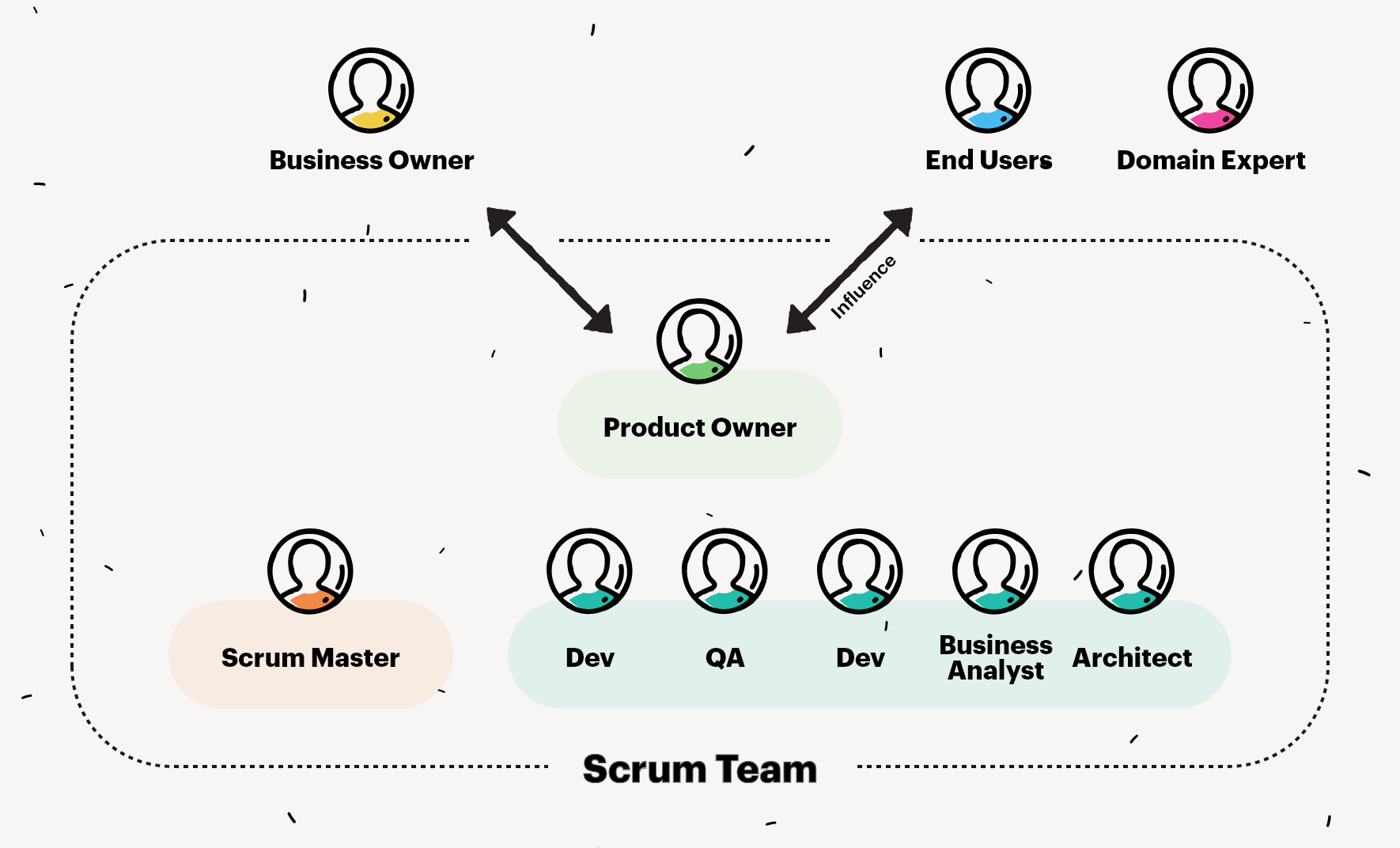
- Product Owner
- Scrum Master
- Scrum Development Team
3.1. What are the responsibilities of the Scrum Product Owner?
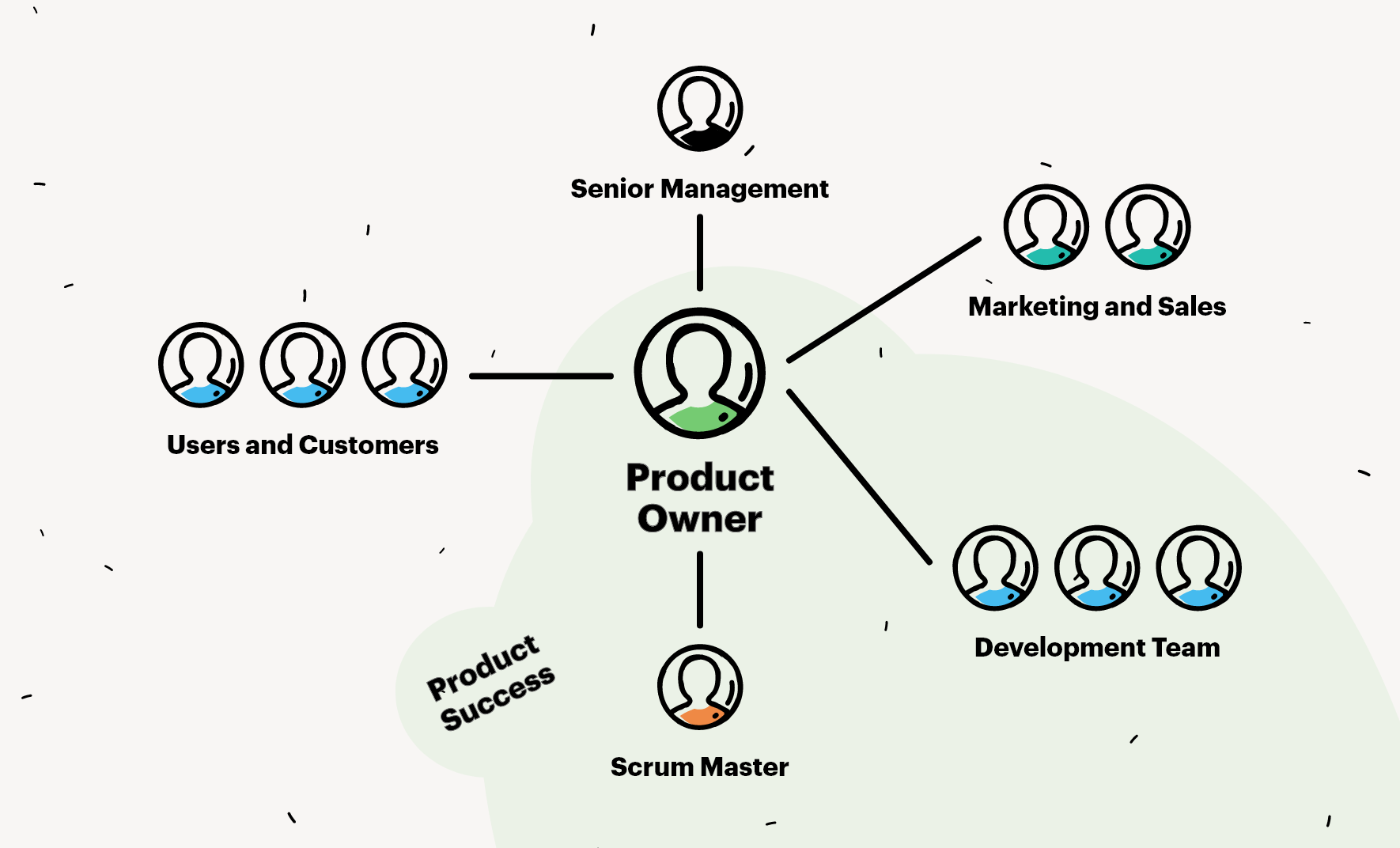
The basic Scrum Role of the Product Owner is to be the link between the final client and the Scrum itself. They hold overall responsibility for the success or failure of a project, they put the ideas and vision into the project and take over all responsibility for priorities and changes of the product throughout development.
3.2. What are the responsibilities of the Scrum Master?
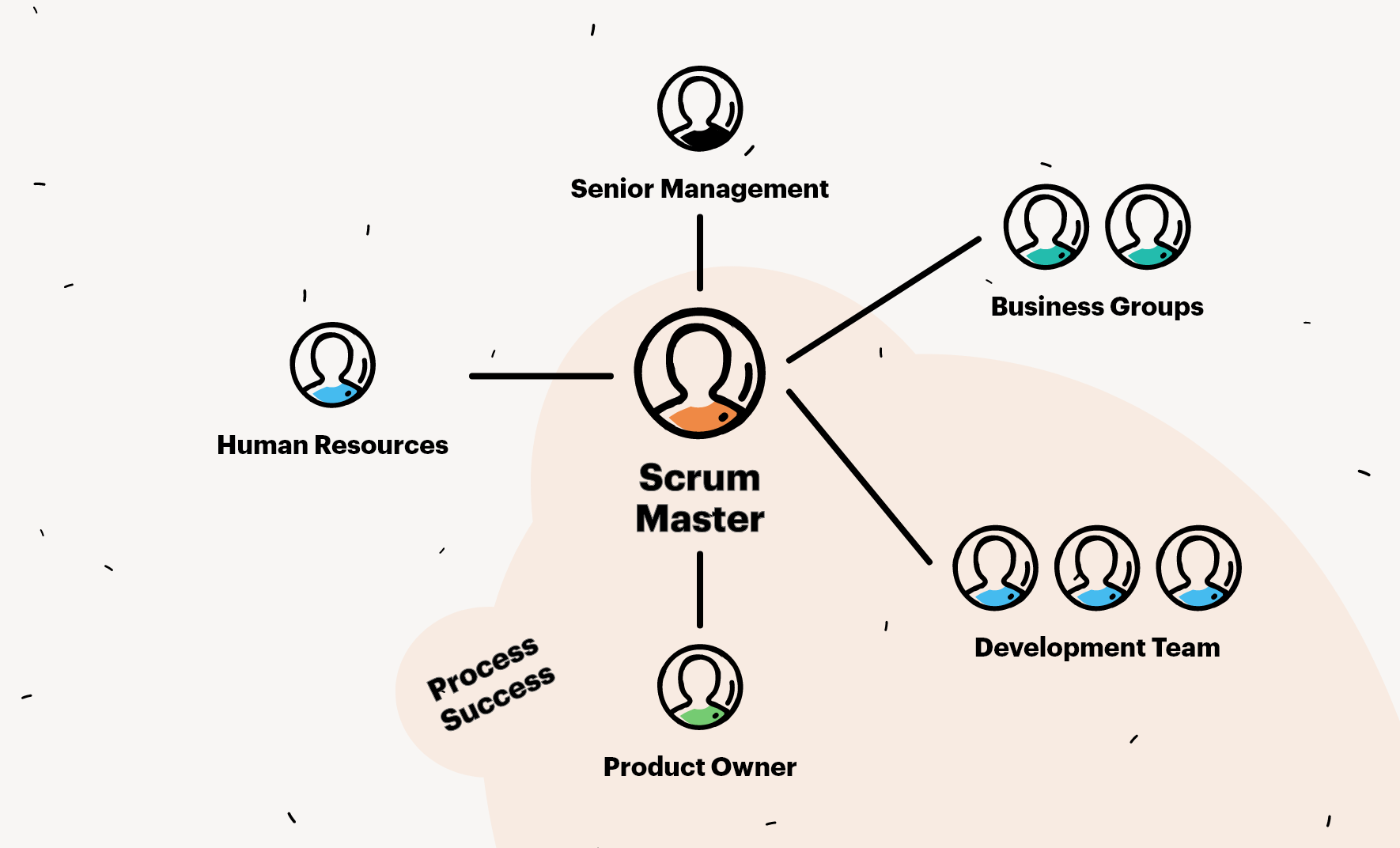
The role of the Scrum Master is often seen as the most crucial in the team. The Scrum Master sets the Scrum agenda and keeps the team aligned to the Scrum basic values. They provide the essential link between the ideas and vision of the Product Owners and the practical, technical abilities and capabilities of the Development team. They organize resources, meetings, and smooth the cogs in the machine allowing the development team to concentrate on the tasks given.
3.3. What are the responsibilities of the Scrum Development Team?
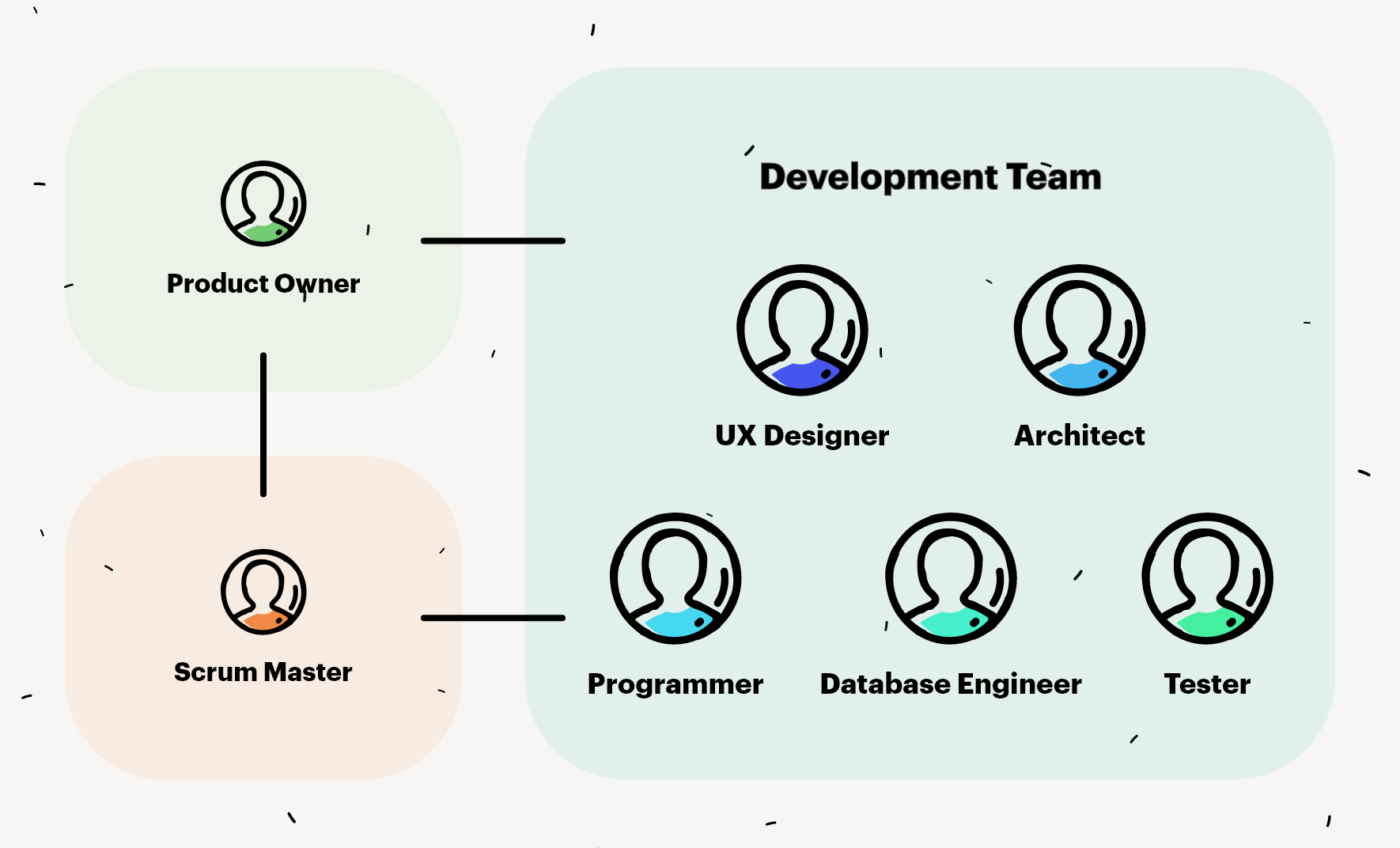
(Снимката подобна на другите – че комуникират с Scrum Master и Product Owner, но да се вкара че са тийм и разнообразни кадри – developers, testers, archiects, designers, Database Engineers)
The Scrum Development team is a relatively small group (3-10 people) that is directly responsible for completing the tasks given. They could be developers, designers, testers, engineers, software architects, etc. They also have responsibility for the input of ideas into meetings, self-organized progress, and reliability as well as helping set tasks and timelines.
4. What are the Scrum Values?
The Scrum values are 5 core behavioral traits of all members of the team throughout the working process.
Commitment
The first principle of Scrum with the others to follow. All team members should be committed to the team and the team goal. Once the culture of commitment is established, follows honesty and trust in the ability to deliver a successful completion of every project.
Courage
At its core, this is the principle of courage to follow the principles. It’s always challenging to break the habits and adopt new ways of working, so Scrum requires the courage to develop, change and improve.
Focus
The third principle is to break down tasks for the team so everyone can know what they’re working on with clear goals. The focus falls entirely on the customer and the team allows the final users to define features that should be a priority.
Openness
Transparency keeps everyone on the same page and holds the team together. It can be achieved with feedback, daily Scrum meetings, Sprint reviews, and retrospectives. The idea is to inspire trust and honesty.
Respect
Each role is important and every member of the team is valuable. It’s important to know that when every team member is dependable and depends on the team, this is how the team functions best. Members of the teams work together and collaborate to improve the whole, which creates an environment of confidence and respect.
5. What are the Scrum Processes?
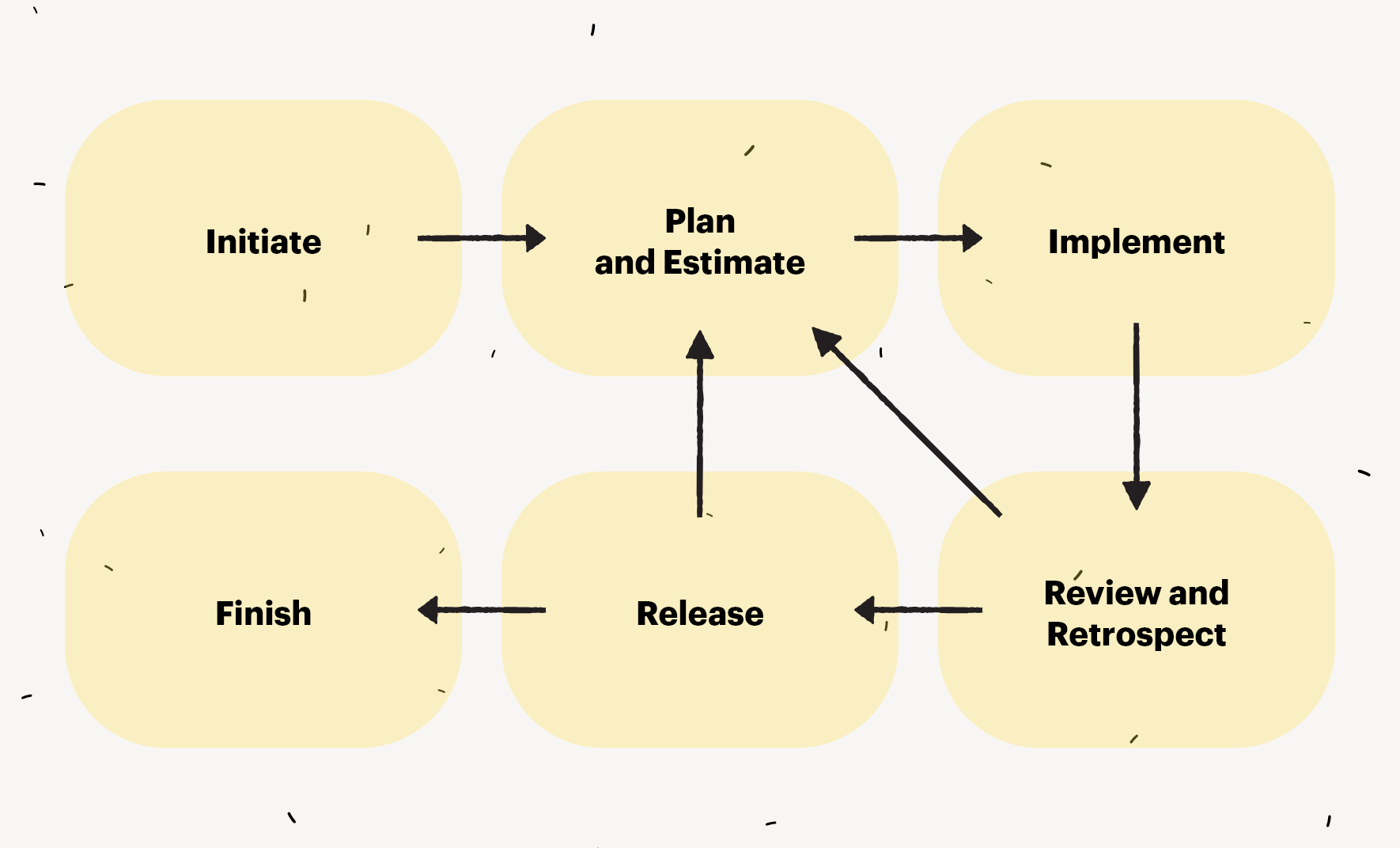
The Scrum is broken down into 5 key repeatable processes or phases.
A – Initiate – everything related to getting the project off the ground from the vision, through choosing the Scrum Master and Development team members to the initial planning and prioritizing of tasks.
B – Planning and Estimating – planning of resources, creation of tasks and time estimates, etc.
C– Implementation – the creation of the product, including the execution of tasks, meetings, reviews, etc.
D – Retrospection – a review phase of each deliverable task, including what has been done and possible improvements.
E – Release – Delivery to the client.
6. What is a Sprint?
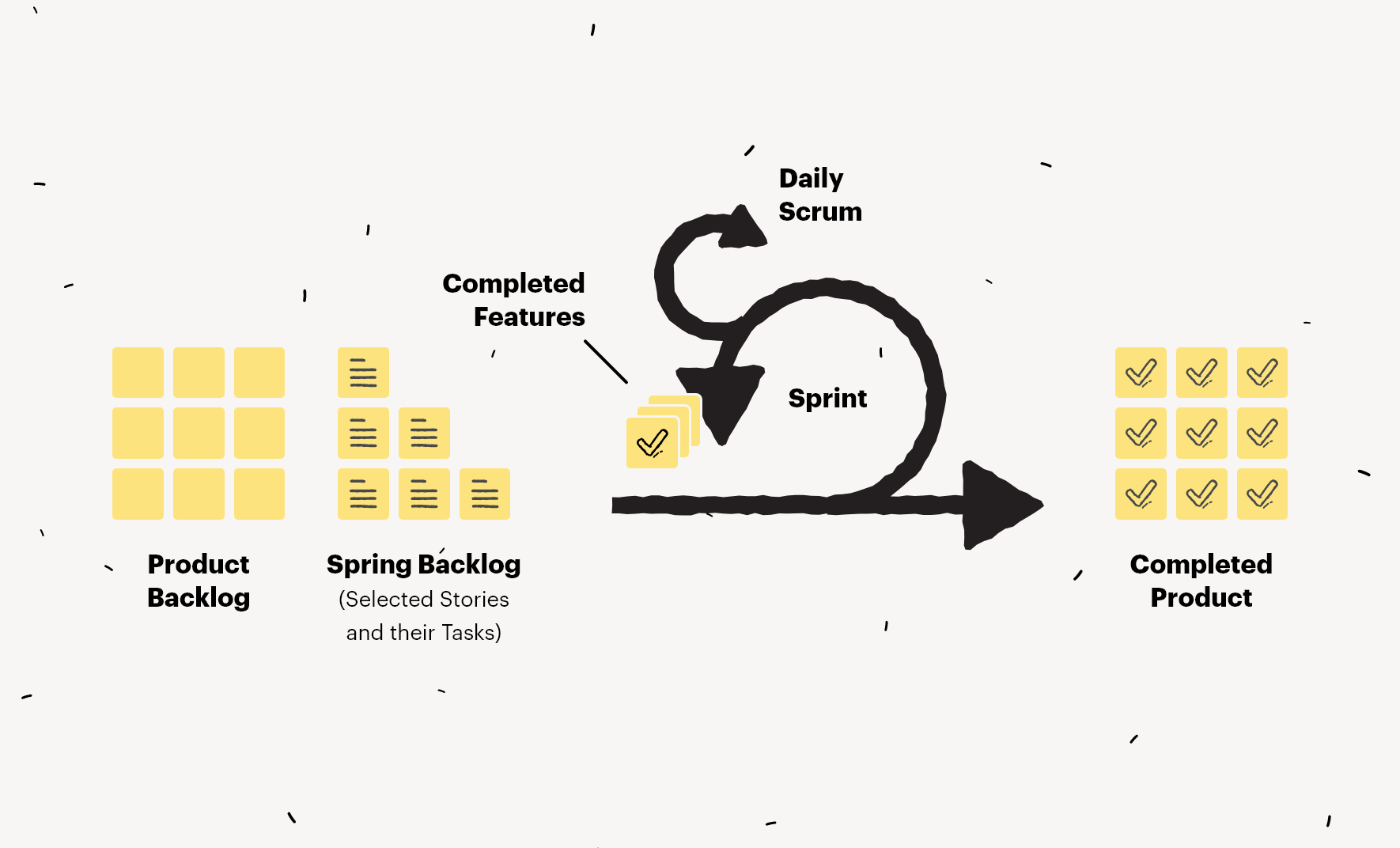
When we talk about Scrum basics, we have to focus on Sprint. this is central to the whole process. Sprint is the term for the set amount of agreed work in a given time (short & limited timeframe). Usually, a Sprint is long around 2 weeks, but no longer than a month.
What are Sprint Scrum Events?
The Scrum Master organizes Sprints around a series of repeated and repeatable events or ceremonies. All of these events have specific terminology related to Scrum. There are 4 repeatable events in Scrum.
Sprint Planning
This is a meeting, attended by the whole team (Product Owner, Scrum Master & Development Team) at the beginning of each project. This is a collaborative meeting in which the aim is a decision on what needs doing and how. The Product Owner should outline the objective, clarify issues, and answer any questions from the team. The Scrum Master chairs the meeting and the Development teams have input throughout including a say on the amount of work and the timescale of each Sprint.
Daily Scrum
The daily scrum is a short meeting, typically at the start of each day, in which the Development team get together and discuss progress, request advice or help and talk through ideas for adaption. In this meeting, the team creates a plan for that day. The Development Team drives this meeting, but it may involve the Scrum Master and/or the Product Owner especially if the Development Team requires or request any extra resources or adaptations.
Sprint Review
At its core, it’s a discussion concerning the work so far completed. The invitations go to all stakeholders including not only the Scrum team but also other affected parties (marketing departments, sales departments, other managers, etc.) Here they inspect the incremental created so far and give feedback.
Sprint Retrospective
Occurring at the end of a Sprint, the sprint retrospective is the meeting in which the whole team analysis the previous sprint. The aim is to assess and review completed goals, look at positive and negative aspects, and make suggestions of how to improve next time. This should lead to an improved plan for the next sprint.
7. What are Scrum Artifacts?
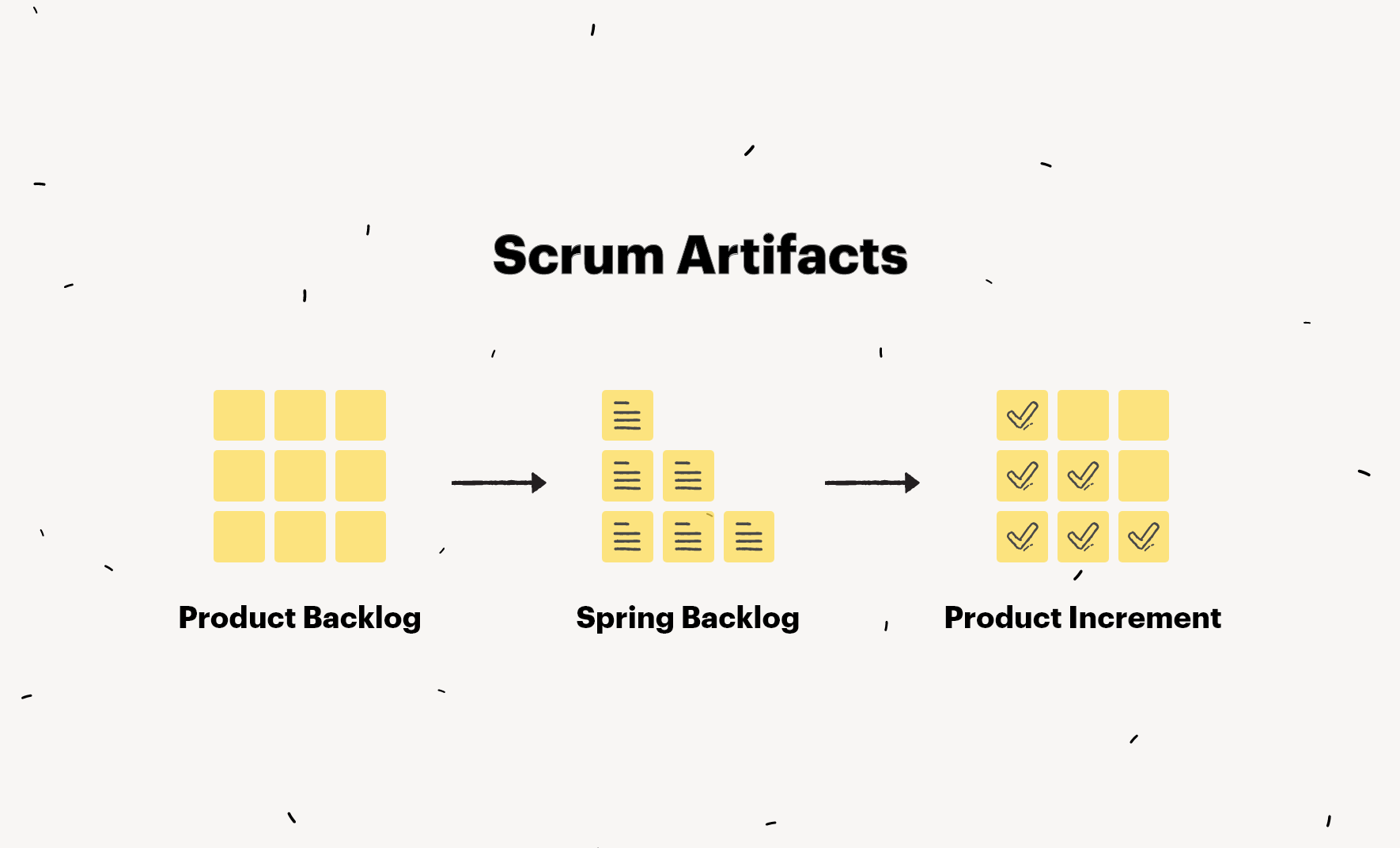
An important part of Scrum basics is the Scrum Artifacts. These are the terms that Scrum users have for the tools created to solve problems. Broken into 3 stages they are a basic “to do”, “doing” “done” breakdown of stages of work. The three artifacts are:
Product Backlog: In short, this is the “to do” list of all the features, functions, and requirements of the final product. The Product Owners sets and manages and also prioritizes this list. The list is flexible, as the product is still dynamic and may change throughout the development stage.
Sprint Backlog: In the Sprint Planning Meeting, the team chooses a specific set of items tasks taken from the Product Backlog. The Sprint Backlog sets the goal of completion of these tasks by a specific time. . The Sprint Backlog often contains a visual element using physical or virtual Scrum Boards to serve as a focal point for the team. This is the “doing” stage.
The Increment: Sometimes referred to as the Sprint Goal, the increment end-product of the Sprint, the “done” stage. The increment can be shown or demonstrated to the stakeholders and even released if appropriate. It must be a usable piece of work.
8. Why Do People Use Scrum?
Scrum teams are flexible to evolve business goals and alter requirements. This dynamic enhances the flexibility and productivity levels of a team, emphasizes teamwork and close collaboration with customers. This is why many project managers adopt this way of developing an agile process for their work environment. As a result, it helps them make sure that the delivered end product matches the customer’s needs.
In order to deal with the core concept of every project that the final deadline must be met, Scrum breaks down work into short chunks with smaller internal deadlines. This strategy creates a sense of urgency and builds up the entire process from reaching milestones.
Conclusion
Although Scrum is a massively popular and growing phenomenon in all businesses, it is particularly so in the software development industry. While we only scratched the surface with Scrum basics, it is full of terminology. However, beyond these terms are some standard and sometimes obvious pointers for managing and controlling projects.
Even without using Scrum, you will have used elements that are familiar. It is worth remembering that whilst a Scrum system is fantastic for some projects, it will not be ideal for all or indeed all teams. You can add to Scrum, inputting your own ideas or ideas of other Agile systems but the essence should remain.
As a result, you get a flexible, team-centered, communication-rich approach where every member of the team has responsibility and accountability and is on the same page.
Finally, such a system should lead to greater motivation, engagement, and a satisfactory outcome for all concerned.
